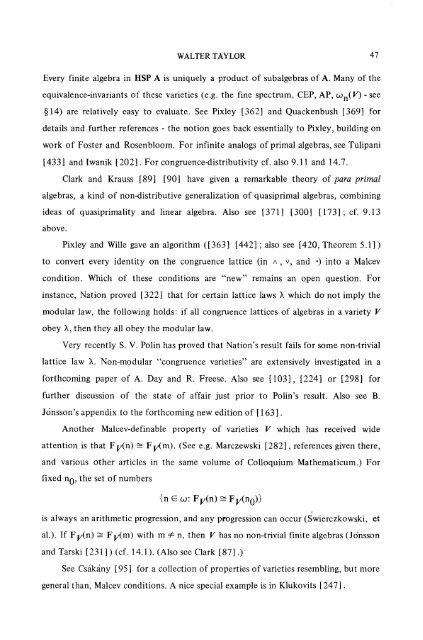Survey 1979: Equational Logic - Department of Mathematics ...
Survey 1979: Equational Logic - Department of Mathematics ...
Survey 1979: Equational Logic - Department of Mathematics ...
You also want an ePaper? Increase the reach of your titles
YUMPU automatically turns print PDFs into web optimized ePapers that Google loves.
WALTER TAYLOR 47<br />
Every finite algebra in HSP A is uniquely a product <strong>of</strong> subalgebras <strong>of</strong> A. Many <strong>of</strong> the<br />
equivalence-invariants <strong>of</strong> these varieties (e.g. the fine spectrum, CEP, AP, Con(V) - see<br />
õ14) are relatively easy to evaluate. See Pixley [362] and Quackenbush [369] for<br />
details and further references - the notion goes back essentially to Pixley, building on<br />
work <strong>of</strong> Foster and Rosenbloom. For infinite analogs <strong>of</strong> primal algebras, see Tulipani<br />
[433] and Iwanik [202]. For congruence-distributivity cf. also 9.11 and 14.7.<br />
Clark and Krauss [89] [90] have given a remarkable theory <strong>of</strong> para primal<br />
algebras, a kind <strong>of</strong> non-distributive generalization <strong>of</strong> quasiprimal algebras, combining<br />
ideas <strong>of</strong> quasiprimality and linear algebra. Also see [371] [300] [173]; cf. 9.13<br />
above.<br />
Pixley and Wille gave an algorithm ([363] [442]; also see [420, Theorem 5.1])<br />
to convert every identity on the congruence lattice (in ^, v, and o) into a Malcev<br />
condition. Which <strong>of</strong> these conditions are "new" remains an open question. For<br />
instance, Nation proved [322] that for certain lattice laws X which do not imply the<br />
modular law, the following holds: if all congruence lattices <strong>of</strong> algebras in a variety V<br />
obey X, then they all obey the modular law.<br />
Very recently S. V. Polin has proved that Nation's result fails for some non-trivial<br />
lattice law X. Non-modular "congruence varieties" are extensively investigated in a<br />
forthcoming paper <strong>of</strong> A. Day and R. Freese. Also see [103], [224] or [298] for<br />
further discussion <strong>of</strong> the state <strong>of</strong> affair just prior to Polin's result. Also see B.<br />
Jdnsson's appendix to the forthcoming new edition <strong>of</strong> [ 163 ].<br />
Another Malcev-definable property <strong>of</strong> varieties V which has received wide<br />
attention is that Fv(n) Fv(m). (See e.g. Marczewski [282], references given there,<br />
and various other articles in the same volume <strong>of</strong> Colloquium Mathematicum.) For<br />
fixed no, the set <strong>of</strong> numbers<br />
{n C co: Fv(n) Fv(n0))<br />
is always an arithmetic progression, and any progression can occur (S'wierczkowski, et<br />
al.). If Fv(n ) - Fv(m ) with m =/= n, then V has no non-trivial finite algebras (Jdnsson<br />
and Tarski [231]) (cf. 14.1 ). (Also see Clark [87] .)<br />
See Csfikiny [95] for a collection <strong>of</strong> properties <strong>of</strong> varieties resembling, but more<br />
general than, Malcev conditions. A nice special example is in Klukovits [247].

















